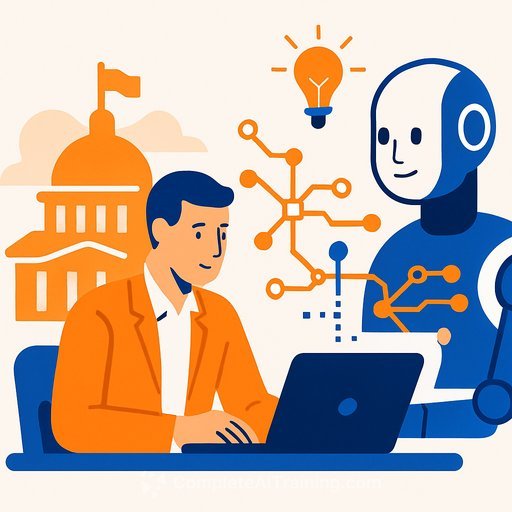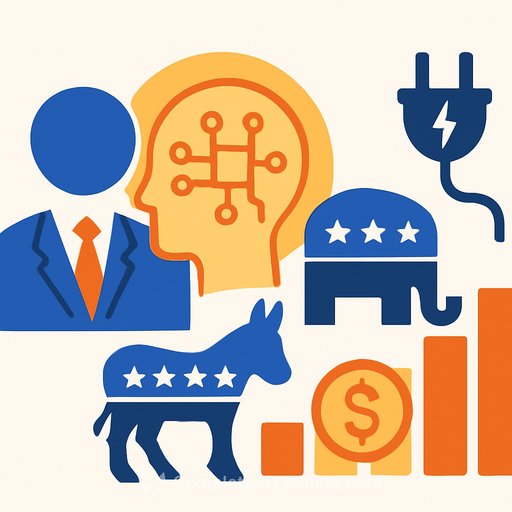Artificial Intelligence: How AI Is Transforming the Way Government Works
AI isn't replacing public servants; it's changing the work. Fewer repetitive tasks, more time for judgment and empathy. The promise is real, but the integration is still maturing - especially on ethics, data protection and workforce impact.
The result: teams are less worried about job loss than before, but the concern hasn't vanished. Clear policy, solid training and smart use cases are what separate value from noise.
How AI Can Help
States are putting AI to work on the basics: drafting emails, summarizing content and powering chatbots for frontline questions. Maryland reports strong gains in daily workflows, plus lighter loads on service centers, according to CIO Katie Savage.
Georgia is seeing similar wins. AI supports cybersecurity operations and helps virtual assistants speed unemployment applications. As CIO Shawnzia Thomas puts it, the tools boost efficiency, accuracy and capacity - freeing people to focus on higher-value work.
New Jersey's AI sandbox has been live for over a year, with roughly 20 percent of the workforce using it. Chief Innovation Officer Dave Cole notes many staff save hours each week by using AI for drafting, editing and document summarization - especially where large volumes of public feedback need to be distilled into actionable insights.
Guardrails Matter
The upside depends on trust. Maryland blocked third-party transcription tools early to protect data and stood up a Responsible AI Policy, backed by a senior adviser for responsible AI. That's the pattern: move fast on value, but faster on security and governance.
There's also the productivity paradox. AI makes it easier to generate resumes and cover letters, which means HR teams face bigger applicant pools with glossier materials - and more time spent filtering for substance. And as chatbots handle simple questions, human agents inherit the hardest, most emotionally charged cases. That's productive on paper, but it can accelerate burnout without staffing and support.
Filling the Skills Gap
Budget pressure and hiring freezes are real. AI can help agencies stretch limited capacity and protect critical services while reducing fraud, waste and abuse, Thomas said.
It also plugs hard-to-fill skill needs. Legacy code like COBOL still runs essential systems, and experts are scarce. AI can assist with maintaining old code. On the data side, tools can handle cleaning and categorization so analysts spend more time on decisions, less time wrangling spreadsheets.
Cybersecurity is another clear fit. As Savage notes, humans can't realistically sift millions of events or connect long-running patterns across IPs and time. AI helps analysts spot what matters and act faster. It can even mine product documentation to streamline software portfolios across agencies.
Job-Replacement Concerns
The fear has shifted. Workers aren't worried about AI outperforming them so much as AI being used to justify downsizing. Public rhetoric at the federal level hasn't helped.
Risk isn't uniform. The narrower and more programmable the task, the higher the exposure to automation. Broader skill sets, higher discretion and cross-functional value reduce that risk - and open doors to new responsibilities.
Leaders can lower anxiety by involving staff directly. In Georgia, teams identify repetitive tasks they want help with. In New Jersey and Maryland, leaders reinforce a simple message: use AI to fill existing gaps and improve service - not to replace people. Real projects that take pressure off workers make that message stick.
What's Next
Expectations are normalizing. Early super-fans are tempering their views, skeptics are seeing practical wins and most agree: AI will automate tasks inside jobs, not entire jobs. Roles evolve. Work shifts. Workforce planning should focus on task reallocation, not elimination.
That makes upskilling urgent. Staff need two types of training: how to use AI effectively in their daily work, and how to grow into higher-value roles as tasks shift. New Jersey paired tools with hands-on training and saw strong adoption. Realistic exercises, prompt practice and clear guidance on bias, hallucinations and data limits make the difference.
Policy will shape the long-term impact. Guardrails around how much authority AI systems have - and where humans must stay in the loop - will determine whether people are seen as the core of public service or the final turn of a screw.
A Practical Playbook for Agencies
- Start with repetitive, rule-based tasks: drafting, summarization, inbox triage, basic Q&A.
- Protect data from day one: block risky tools, set a Responsible AI Policy and review vendor terms.
- Keep humans front and center: use AI to augment, not replace. Show examples that reduce backlog and burnout.
- Triage smarter: let chatbots handle simple questions, but add escalation paths, context handoff and time for agents to decompress.
- Target capacity gaps: cybersecurity log analysis, legacy systems support, document mining for policy and procurement.
- Pair tools with training: hands-on practice, scenario prompts, bias checks and clear data-handling rules.
- Measure outcomes: hours saved, error rates, cycle time, citizen satisfaction and staff well-being.
- Iterate with a sandbox: invite staff to propose use cases, test safely and scale what works.
Resources
For workforce implications and case studies, see the Roosevelt Institute's report, AI and Government Workers. For practical public-sector upskilling, explore InnovateUS.
If you're building role-based learning plans for your team, browse job-focused AI pathways here: Complete AI Training: Courses by Job.
Final Thought
AI won't do your job for you. It will change what your job is. Agencies that protect data, involve their people and train for real use will move faster - and serve better - without burning out their teams.
Your membership also unlocks:






